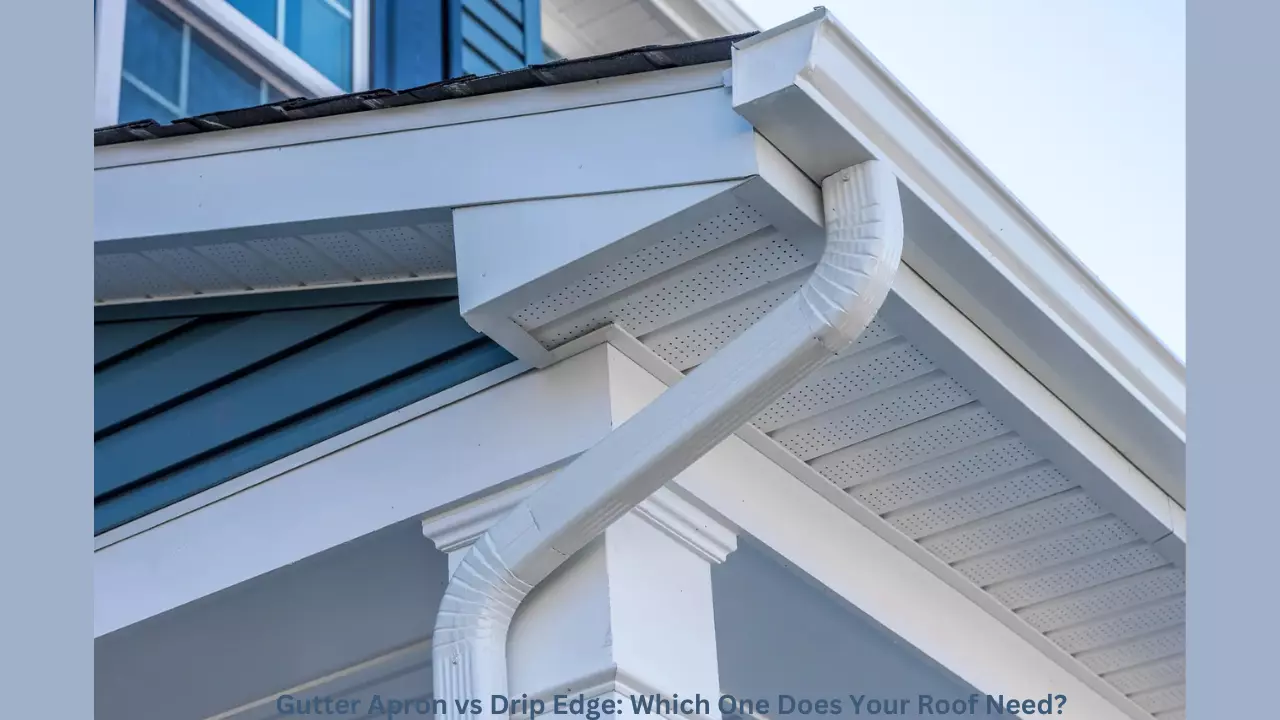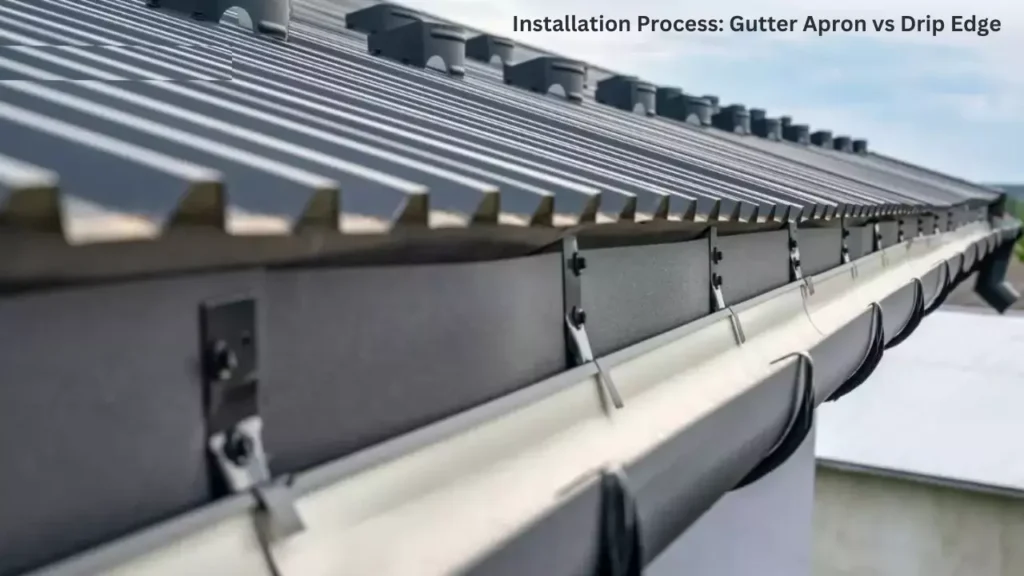Gutter Apron vs Drip Edge: Which One Does Your Roof Need?

Roof maintenance is critical to the long-term durability of your home. A small oversight in how water drains from your roof can lead to costly repairs down the line. This is where two essential roofing components—gutter apron vs drip edge—come into play. Both serve the purpose of controlling water, but their functions differ, and knowing which one to use makes a significant difference.
In this article, we’ll explain the differences between a gutter apron and a drip edge, how they work, and why both are essential for protecting your roof. We’ll also look at situations when you might need one over the other or even both.
What is a Gutter Apron?
A gutter apron is a piece of metal flashing installed between the roof edge and the gutter. Its primary job is to ensure that rainwater flows seamlessly into the gutter rather than behind it. When water bypasses the gutter, it can cause damage to the fascia, soffit, and siding, leading to rot and mold issues.
Made from materials such as aluminum, galvanized steel, or copper, gutter aprons have an L-shaped design that fits under the roofing material and extends over the gutter. This extension ensures that water cannot sneak behind the gutter and accumulate in areas that should remain dry.
What is a Drip Edge?
A drip edge is another type of metal flashing, but it is designed to direct water away from the roof edges and protect the underlying structure. It keeps water from wicking into the roof deck and fascia boards, reducing the risk of moisture damage. Installed along the eaves and rakes, drip edges ensure that water drips directly off the roof without touching the fascia.
Drip edges are often installed on all roof edges, whether or not a gutter system is in place. The slight overhang of the drip edge prevents water from creeping under the shingles and helps maintain the integrity of the roof over time.
Gutter Apron vs Drip Edge: Key Differences
While both gutter aprons and drip edges help manage water flow, their installation locations and purposes differ. A gutter apron is specifically used with gutters to prevent water from flowing behind them, while a drip edge works to direct water off the roof.
| Feature | Gutter Apron | Drip Edge |
|---|---|---|
| Location | Along the roof eaves above the gutters | Along the entire roof perimeter (eaves & rakes) |
| Primary Function | Prevent water from sneaking behind gutters | Direct water away from the roof deck and fascia |
| Best Used With | Gutter systems | Any roof, with or without gutters |
| Material | Aluminum, copper, or galvanized steel | Aluminum, galvanized steel, or vinyl |
| Design | L-shaped, extends into gutter | T-shaped or L-shaped with a slight overhang |
When to Use a Gutter Apron?
A gutter apron is essential when you have gutters installed. Gutters are designed to capture and channel water away from the foundation of your house, but without a gutter apron, water can slip behind the gutter. This issue becomes more pronounced during heavy rainfall, when water flow is more significant, and backflow behind the gutters can cause considerable damage to your fascia boards and soffit.
Homeowners in regions with frequent heavy rainfall should ensure that a gutter apron is part of their roofing system. Even if you already have gutters installed, adding a gutter apron can provide an additional layer of water control.
When to Use a Drip Edge?
A drip edge should be used on any roof, whether or not it has a gutter system. Without a drip edge, water can run down the edges of your roof, getting absorbed into the fascia boards and damaging the roof deck over time. This can lead to mold formation, rot, and leaks in your home.
For homes without gutters, the drip edge ensures that water falls directly off the roof and does not run along the roof edge, keeping the house structure intact. In snowy climates, a drip edge also prevents ice dams from forming at the roof edge.
Can You Use Both Gutter Apron and Drip Edge?
In some cases, using both a gutter apron and a drip edge can offer maximum protection. A combination is especially useful if your home is located in an area with heavy rains, strong winds, or significant snowfall. The drip edge will protect the roof deck and fascia, while the gutter apron ensures water flows into the gutter without leaking behind it.
Installation Process: Gutter Apron vs Drip Edge

The installation process for both these elements differs slightly. A gutter apron is installed along the eaves, with one side tucked under the shingles and the other over the gutter. On the other hand, the drip edge goes under the shingles and extends slightly beyond the fascia, ensuring water drips off cleanly.
If you are installing both, the drip edge goes in first, followed by the gutter apron. This order ensures optimal water management from both elements.
Materials Used for Gutter Apron and Drip Edge
Both gutter aprons and drip edges come in materials like aluminum, galvanized steel, and copper. The choice of material depends on the roofing material and climate. Aluminum is lightweight and resistant to rust, making it a popular choice for many homes. Galvanized steel offers greater durability but can rust over time if not coated properly. Copper, although expensive, provides a unique aesthetic and is highly durable.
Cost Differences
The cost of gutter aprons and drip edges varies based on the material used and the size of your roof. In general, drip edges are slightly more affordable. Because they are installed on all types of roofs, with or without gutters. Gutter aprons might cost a bit more if retrofitted onto existing roofs with gutters, but the added expense is worth it to prevent future repairs.
| Component | Average Cost per Linear Foot | Common Material |
|---|---|---|
| Gutter Apron | $2 – $4 | Aluminum, galvanized steel, copper |
| Drip Edge | $1 – $3 | Aluminum, vinyl, galvanized steel |
Frequently Asked Questions
Can I install both a gutter apron and a drip edge on my roof?
Yes, you can install both. The drip edge is installed first to protect the roof edges. The gutter apron goes above it to direct water into the gutter.
Do I need a drip edge if I already have a gutter apron?
Yes, a drip edge is still recommended to prevent water from soaking into the fascia or roof deck. Especially along roof rakes that do not have gutters.
Which one is more important: the gutter apron or the drip edge?
Both are important for different reasons. A gutter apron is essential for areas with gutters. While a drip edge is necessary for preventing moisture damage across the entire roof.
Can I install a gutter apron or drip edge myself?
While it’s possible for experienced DIYers, professional installation is recommended to ensure proper alignment and long-term protection against water damage.
Conclusion
Choosing between a gutter apron vs a drip edge depends on your roof’s specific needs. If you have gutters installed. A gutter apron is essential to prevent water from sneaking behind the gutter and causing damage. On the other hand, a drip edge is necessary for any roof to guide water away from the fascia. And prevent moisture from seeping into the roof deck.






